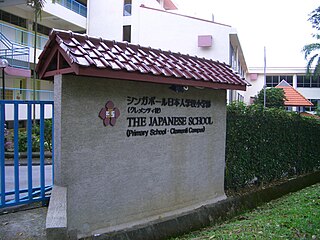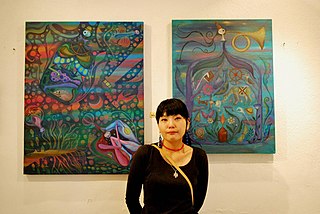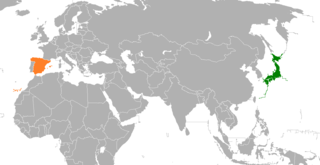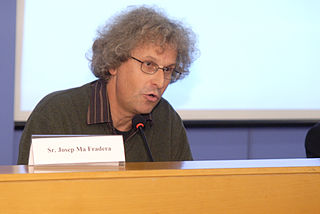
The Eixample is a district of Barcelona between the old city and what were once surrounding small towns, constructed in the 19th and early 20th centuries. Its population was 262,000 at the last census (2005).

Sant Cugat del Vallès is a town and municipality north of Barcelona, Catalonia. Known as Castrum Octavianum in antiquity and as Pins del Vallès during the Second Spanish Republic, it is named after Saint Cucuphas, who is said to have been martyred on the spot now occupied by its medieval monastery. The final part of its toponym, del Vallès, is a reference to the historical county where the town is situated, Vallès.

Nihonjin gakkō, also called Japanese school, is a full-day school outside Japan intended primarily for Japanese citizens living abroad. It is an expatriate school designed for children whose parents are working on diplomatic, business, or education missions overseas and have plans to repatriate to Japan.

Liceo Mexicano Japonés, A.C. ; Japanese: 社団法人日本メキシコ学院, romanized: Shadan Hōjin Nihon Mekishiko Gakuin, or [日墨学院] Error: {{Lang}}: invalid parameter: |3= (help), transl. Japan-Mexico Institute) is a Japanese school based in the Pedregal neighborhood of the Álvaro Obregón borough in southern Mexico City, Mexico.
Spanish people of Filipino ancestry or Filipinos in Spain are an ethnic and multilingualistic group in Spain, consisting of citizens and the descendants of early migrants from the Philippines to Spain, as well as more recent migrants. Some 200,000 Filipinos are estimated to live in Spain, including 37,000 expatriates from the Philippines living in Spain who are either Spanish citizens or do not hold any citizenship.

Japanese Mexicans are Mexican citizens of Japanese descent. Organized Japanese immigration to Mexico occurred in the 1890s with the foundation of a coffee-growing colony in the state of Chiapas. Although this initiative failed, it was followed by greater immigration from 1900 to the beginning of World War II. However, it never reached the levels of Japanese immigration to the Americas such as Brazil or the United States.
Japanese Paraguayans are Paraguayans of Japanese ethnicity.
Japanese Bolivians are Bolivians of Japanese ancestry or Japanese-born people who reside in Bolivia.
Japanese Dominicans are Dominican citizens of Japanese origin. Japan's Ministry of Foreign Affairs estimates the Japanese descended population in the country at roughly 800. As of 2013, there were also 873 Japanese nationals in the Dominican Republic. These consist of both the settlers who have retained their Japanese citizenship and more recent expatriate residents. The Dominican Republic has the largest Japanese population in the Caribbean and Central American region.
Koreans in Spain form one of the country's smaller Asian populations.

Japan–Uruguay relations are foreign relations between Japan and Uruguay. Both countries are members of the United Nations and the World Trade Organization.
The 1582 Cagayan battles were a series of clashes between the forces of the Spanish Philippines led by Captain Juan Pablo de Carrión and wokou headed by Tay Fusa. These battles, which took place in the vicinity of the Cagayan River, finally resulted in a Spanish victory.AB

The Japanese School in Barcelona is a Japanese international school in Sant Cugat del Vallès, Catalonia, Spain, in Greater Barcelona. It is about 10 kilometres (6.2 mi) northeast of central Barcelona. Many Japanese families live along the school's bus route in northern Barcelona.

The Colegio Japonés de Madrid (CJM) is a Japanese international school in the El Plantío area of Moncloa-Aravaca, Madrid, in the city's northwestern portion. Many Japanese families, particularly those with children, live in northwest Madrid, in proximity to the school. It was established on 1 September 1981.

Mexico City has a community of Japanese Mexican people and Japanese expatriates that is dispersed throughout the city. Many Japanese persons had moved to Mexico City in the 1940s due to wartime demands made by the Mexican government. Multiple Japanese-Mexican associations, the Japanese embassy, the Liceo Mexicano Japonés, and other educational institutions serve the community. The residents are educated through the LMJ, the part-time school Chuo Gakuen, and the adult school Instituto Cultural Mexicano-Japonés.

Maria Lluïsa Borràs i González, doctorate in Art History from the Universitat de Barcelona, was a Spanish writer, critic, exhibition curator and specialist in the avant-garde and Dadaism.

Japan–Spain relations are the bilateral relations between Japan and Spain. Both nations are members of the Organisation for Economic Co-operation and Development.

Colegio Japonés de Las Palmas was a Japanese international school in Tafira Alta, Las Palmas de Gran Canaria, Spain.

Florentino Rodao García is a Spanish historian and Japanologist. His historical research deals with Asian studies and international relations. He is full professor of the Complutense University of Madrid (UCM).

Josep Maria Fradera i Barceló is a Spanish historian, professor of Contemporary History at the Pompeu Fabra University. Specialised in the colonial system of the late Spanish Empire, he has also studied the history of Catalonia.
















